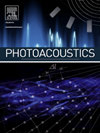投稿信息
稿件收录要求
The aim of the open access Photoacoustics journal (PACS) is to publish original research and review contributions within the fast-growing field of photoacoustics-optoacoustics-thermoacoustics, which exploits acoustical and ultrasonic phenomena excited by electromagnetic radiation for purposes of detection, visualization, and characterization of a variety of materials and biological tissues, including living organisms.
Many research directions in photoacoustics, especially biomedical optoacoustic imaging experience explosive growth in the 21st century. The wealth of investigated topics indicates that this field has developed a broad range of tools for fundamental and applied research. The enormous recent progress is greatly supported by the advances in laser technologies, ultrasound detection approaches, development of inverse theory, and fast reconstruction algorithms. This progress is also driven by a large number of unmet biological and medical needs that can be addressed by the unique contrast of molecular absorption available to photoacoustic - optoacoustic - thermoacoustic methods. These include pre-clinical research and clinical imaging of vasculature, tissue and disease physiology, drug efficacy, surgery guidance, and therapy monitoring. Correspondingly applications span the entire range of medical imaging and sensing applications including cancer, vascular diseases, brain neurophysiology, ophthalmology, and diabetes. Recent technological advances enabled cell trafficking applications and measurements of a multitude of other biological functions. The multidisciplinary nature of photoacoustics - optoacoustics - thermoacoustics is also evidenced by the growing contribution from chemistry and nanotechnology where a variety of novel biodegradable materials from nanoparticles to organic dyes, to targeted agents, theranostic probes and genetically expressed markers are being actively developed. Significant enhancement of the signal-to-noise ratio and tissue contrast in photoacoustic methods has been achieved employing these advanced materials.
While some of the spectroscopic and sensing applications in non-biomedical materials have reached a mature state, Photoacoustics supports the research community that develops novel industrial and environmental applications, nondestructive evaluation of materials and new ultrawideband transducers (piezoelectric, capacitive and optical) for sensitive detection of photoacoustic - optoacoustic - thermoacoustic signals.
The list of topics of interest includes (but is not limited to) the following:
- Tomography and deep-tissue imaging
- Mesoscopy, microscopy, and nanoscopy
- Functional and molecular imaging and sensing
- Contrast agents, molecular probes, and nanoparticles
- Interactions with cells and tissues
- Pre-clinical imaging, clinical translation, and clinical applications
- Multi-modality systems involving light and sound
- Microwave induced ultrasound imaging and sensing
- Laser ultrasound methods and applications
- Physics and modeling of photoacoustic generation, propagation and detection
- Signal processing, advanced filtering and artifact removal
- Image reconstruction algorithms including deep learning
- Computer assisted diagnostics based on artificial intelligence
- Ultrawide-band ultrasound detectors, optical detectors of ultrasound
- Novel lasers and light delivery technologies for the generation of ultrasound
- Spectroscopy and analysis of compounds
- Nondestructive testing of materials
Keywords: PACS, photoacoustic, optoacoustic, thermoacoustic, laser ultrasound (supplemental keywords: imaging, sensing, monitoring, evaluation, tomography, microscopy, theranostics, contrast agents, nanotechnology).




